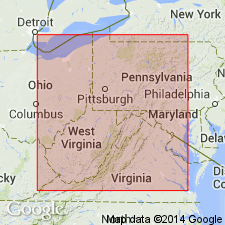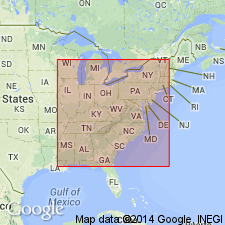
- Usage in publication:
-
- Clarksburg limestone*
- Modifications:
-
- Named
- Dominant lithology:
-
- Limestone
- AAPG geologic province:
-
- Appalachian basin
Summary:
Named for exposures along bed of Elk and West Fork Rivers, near Clarksburg, Harrison Co., northern WV. Consists of limestone. Upper part is rather slaty; beneath this, layers are compact and weather into rhomboidal blocks; some layers are ferruginous. Thickness is 20 to 30 ft. Directly underlies Little Clarksburg coal; separated from underlying Morgantown sandstone by 25 to 40 ft of soft shale.
Source: GNU records (USGS DDS-6; Reston GNULEX).

- Usage in publication:
-
- Clarksburg limestone
- Modifications:
-
- Overview
- AAPG geologic province:
-
- Appalachian basin
Summary:
Unit is an unranked brackish-water limestone in the Conemaugh Group exposed along Elk Creek and West Fork River near Clarksburg, WV. Occurs between Clarksburg coal or underclay (above) and Morgantown sandstone in WV and OH. In PA and MD, unit is commonly found in two beds referred to as Upper and Lower Clarksburg limestones by Flint (1965).
Source: GNU records (USGS DDS-6; Reston GNULEX).
For more information, please contact Nancy Stamm, Geologic Names Committee Secretary.
Asterisk (*) indicates published by U.S. Geological Survey authors.
"No current usage" (†) implies that a name has been abandoned or has fallen into disuse. Former usage and, if known, replacement name given in parentheses ( ).
Slash (/) indicates name conflicts with nomenclatural guidelines (CSN, 1933; ACSN, 1961, 1970; NACSN, 1983, 2005, 2021). May be explained within brackets ([ ]).

